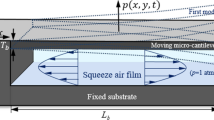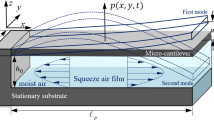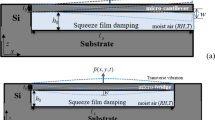Abstract
In this paper, the effect of relative humidity of moist air is discussed on the quality factor (Q factor) of micro-electro-mechanical systems (MEMS) cantilever resonators in wide range of gas rarefaction (ambient pressure and accommodation coefficients, ACs). The modified molecular gas lubrication (MMGL) equation is used to model the squeeze film damping problem of MEMS cantilever resonators. Dynamic viscosity and Poiseuille flow rate are used to modify the MMGL equation to consider the coupled effects of relative humidity and gas rarefaction. Thermoelastic damping and anchor loss, which are dominant damping mechanisms of MEMS cantilever resonators, are also included to calculate total Q factor. Thus, the influences of relative humidity are discussed on the Q factors of MEMS cantilever resonators in wide range of gas rarefaction and dimension of cantilever. The results showed that the Q factor decreases as relative humidity increases in wide range of gas rarefaction (pressure, and ACs) and dimension of cantilever (length, width, and thickness). The influences of relative humidity on the Q factor become more significantly in larger length, larger width, smaller thickness of cantilever, and higher gas rarefaction (lower pressure and ACs). Whereas, the influences of relative humidity on the Q factor reduce or are neglected in smaller length, larger thickness of cantilever and lower gas rarefaction (higher pressure and ACs).










Similar content being viewed by others
References
Baller MK, Lang HP, Fritz J, Gerber Ch, Gimzewski JK, Drechsler U, Rothuizen H, Despont M, Vettiger P, Battiston FM, Ramseyer JP, Fornaro P, Meyer E, Güntherodt HJ (2000) A cantilever array-based artificial nose. Ultramicroscopy 82:1–9
Bao M, Yang H (2007) Squeeze film air damping in MEMS. Sens Actuators A Phys 136:3–27
Bircher BA, Krenger R, Braun T (2014) Influence of squeeze-film damping on higher-mode microcantilever vibrations in liquid. EPJ Tech Instrum 1:1–10
Burg TP, Manalis SR (2003) Suspended microchannel resonators for biomolecular detection. Appl Phys Lett 83:2698–2700
COMSOL 5.4 (2018) COMSOL Multiphysics. https://www.comsol.com/
Ghaffari S, Ng EJ, Ahn CH, Yang Y, Wang S, Hong VA, Kenny TW (2015) Accurate modeling of quality factor behavior of complex silicon MEMS resonators. J Microelectromech Syst 24:276–288
Gupta A, Akin D, Bashir R (2004) Single virus particle mass detection using microresonators with nanoscale thickness. Appl Phys Lett 84:1976–1978
Hao Z, Erbil A, Ayazi F (2003) An analytical model for support loss in micromachined beam resonators with in-plane flexural vibrations. Sens Actuators A Phys 109:156–164
Hasan MH, Ouakad HM, Alsaleem F (2017) On the effects of temperature and relative humidity on the response of a MEMS arch resonator. In: ASME 2017 international design engineering technical conferences and computers and information in engineering conference (IDETC/CIE 2017), Cleveland, Ohio, pp 1–10
Hosaka H, Itao K, Kuroda S (1995) Damping characteristics of beam-shaped micro-oscillators. Sens Actuators A Phys 49:87–95
Hosseinzadegan H, Pierron ON, Hosseinian E (2014) Accurate modeling of air shear damping of a silicon lateral rotary micro-resonator for MEMS environmental monitoring applications. Sens Actuators A Phys 216:342–348
Hwang CC, Fung RF, Yang RF, Weng CI, Li WL (1996) A new modified Reynolds equation for ultrathin film gas lubrication. IEEE Trans Magn 32:344–347
Ilic B, Czaplewski D, Craighead HG, Neuzil P, Campagnolo C, Batt C (2000) Mechanical resonant immunospecific biological detector. Appl Phys Lett 77:450–452
Jan MT, Ahmad F, Hamid NHB, Khir MHBM, Shoaib M, Ashraf K (2016) Experimental investigation of temperature and relative humidity effects on resonance frequency and quality factor of CMOS-MEMS paddle resonator. Microelectron Reliab 63:82–89
Jandak M, Neuzil T, Schneider M, Schmid U (2016) Investigation on different damping mechanisms on the Q factor of MEMS resonators. Procedia Eng 168:929–932
Johnson BN, Mutharasan R (2012) Biosensing using dynamic-mode cantilever sensors: a review. Biosens Bioelectron 32:1–18
Kim B, Hopcroft MA, Candler RN, Jha CM, Agarwal M, Melamud R, Chandorkar SA, Yama G, Kenny TW (2008) Temperature dependence of quality factor in MEMS resonators. J Microelectromech Syst 17:755–766
Kim SJ, Dean R, Jackson RL, Flowers GT (2011) An investigation of the damping effects of various gas environments on a vibratory MEMS device. Tribol Int 44:125–133
Kreith F, Goswami DY (2005) The CRC handbook of mechanical engineering. CRC Press LLC, Boca Raton, p 1385
Lang HP, Berger R, Battiston F, Ramseyer JP, Meyer E, Andreoli C, Brugger J, Vettiger P, Despont M, Mezzacasa T, Scandella L, Güntherodt HJ, Gerber Ch, Gimzewski JK (1998) A chemical sensor based on a micromechanical cantilever array for the identification of gases and vapors. Appl Phys A Mater 66:S61–S64
Lang HP, Hegner M, Gerber C (2005) Cantilever array sensors. Mater Today 8:30–36
Lee JW (2011) Analysis of fuid-structure interaction for predicting resonant frequencies and quality factors of a microcantilever on a squeeze-film. J Mech Sci Technol 25:3005–3013
Leissa AW (1969) Vibration of plates. NASA, Washington, DC, pp 1–6
Li WL (2002) A database for Couette flow rate considering the effects of non-symmetric molecular interactions. J Tribol Trans ASME 124:869–873
Li WL (2003) A database for interpolation of Poiseuille flow rate for arbitrary Knudsen number lubrication problems. J Chin Inst Eng 26:455–466
Li WL (2004) Modeling of head/disk interface—an average flow model. Tribol Lett 17:669–676
Li WL (2008) Squeeze film effects on dynamic performance of MEMS μ-mirrors-consideration of gas rarefaction and surface roughness. Microsyst Technol 14:315–324
Lifshitz R, Roukes ML (2000) Thermoelastic damping in micro- and nanomechanical systems. Phys Rev B 61:5600–5609
Mertens J, Finot E, Nadal MH, Eyraud V, Heintz O, Bourillot E (2004) Detection of gas trace of hydrofluoric acid using microcantilever. Sens Actuators B Chem 99:58–65
Morvay ZK, Gvozdenac DD (2008) Applied industrial energy and environmental management. John Wiley and Sons Ltd, p 429
Nayfeh AH, Younis MI (2004) A new approach to the modeling and simulation of fexible microstructures under the effect of squeeze flm damping. J Micromech Microeng 14:170–181
Nguyen CC, Li WL (2017a) Effect of gas rarefaction on the quality factors of micro-beam resonators. Microsyst Technol 23:3185–3199
Nguyen CC, Li WL (2017b) Effects of surface roughness and gas rarefaction on the quality factor of micro-beam resonators. Microsyst Technol 23:3489–3504
Nguyen CC, Li WL (2017c) Influences of temperature on the quality factors of micro-beam resonators in gas rarefaction. Sens Actuators A Phys 261:151–165
Nieva PM, McGruer NE, Adams GG (2006) Design and characterization of a micromachined Fabry–Perot vibration sensor for high-temperature applications. J Micromech Microeng 16:2618–2631
Ouakad HM, Al-Qahtani HM, Hawwa MA (2016) Influence of squeeze-film damping on the dynamic behavior of a curved micro-beam. Adv Mech Eng 8:1–8
Pandey AK, Pratap R (2007) Effect of flexural modes on squeeze film damping in MEMS cantilever resonators. J Micromech Microeng 17:2475–2484
Prabhakar S, Vengallatore S (2007) Thermoelastic damping in bilayered micromechanical beam resonators. J Micromech Microeng 17:532–538
Saraireh M (2012) Heat transfer and condesation of water vapour from humid air in compact heat exchangers. Doctor of Philosophy, Victoria University, Footscray, p 67
Slowikowski M, Naterer GF, Odukoya A (2014) Diffusion properties of aqueous slurries in evaporative spray drying of copper(II) chloride dihydrate. Heat Mass Transf 50:1195–1210
Takahashi H, Dung NM, Matsumoto K, Shimoyama I (2012) Differential pressure sensor using a piezoresistive cantilever. J Micromech Microeng 22:055015
Tan Z (2014) Air pollution and greenhouse gases. Springer Science + Business Media, Singapore, pp 33–34
Turner WC, Doty S (2007) Energy management handbook. The Fairmont Press Inc, Lilburn, p 822
Veijola T, Kuisma H, Lahdenperä J, Ryhänen T (1995) Equivalent-circuit model of the squeezed gas film in a silicon accelerometer. Sens Actuators A Phys 48:239–248
Veijola T, Kuisma H, Lahdenpera J (1997) Model for gas film damping in a silicon accelerometer. In: Solid state sensors and actuators, 1997, transducers ’97, Chicago, pp 1097–1100
Yagubizade H, Younis MI, Rezazadeh G (2009) The effect of squeeze-film damping on suppressing the shock response of MEMS. In: ASME 2009 international mechanical engineering congress and exposition (IMECE 2009), Florida, USA, pp 1–6
Younis MI, Nayfeh AH (2005) Modeling squeeze-film damping of electrostatically actuated microplates undergoing large deflections. In: ASME 2005 international design engineering technical conferences and computers and information in engineering conference (IDETC/CIE 2005), California, USA, pp 1–10
Zener C (1937) Internal friction in solids. I. Theory of internal friction in reeds. Phys Rev 52:230–235
Zener C (1938) Internal friction in solids II. General theory of thermoelastic internal friction. Phys Rev 53:90–99
Zhou H, Li P, Zuo W (2016) Thermoelastic damping in micro-wedged cantilever resonator with rectangular cross-section. In: IEEE 2016 international conference on mechatronics and automation (ICMA), Harbin, China, pp 1590–1595
Acknowledgements
This research was supported by the Ho Chi Minh City Department of Science and Technology of Vietnam, Contract number: 15/2018/HĐĐT–TTR&D.
Author information
Authors and Affiliations
Corresponding author
Additional information
Publisher's Note
Springer Nature remains neutral with regard to jurisdictional claims in published maps and institutional affiliations.
Appendices
Appendix 1
In this result, Q factor of TED (QTED) is calculated and plotted as function of length (Lb) and thickness (Tb) of cantilever, respectively. The material properties of silicon cantilever are implemented as the thermal conductivity \(\kappa\) = 90 W/(m K), the specific heat capacity \(C_{P}\) = 700 J/(kg K). In Fig. 11, the result shown that QTED increases as Lb increases. In Fig. 12, the result shown that QTED decreases down to a minimum value and then increases as Tb increases. Furthermore, the obtained results of QTED from the FEM model (COMSOL 2018) shown good agreement with those obtained results from Zener (1937, 1938) model and LR (Lifshitz and Roukes (2000)) model in wide range of length (Lb) and thickness (Tb) of cantilever. Then, the obtained results of QTED from Zener (1937, 1938) model are applied in the present analysis. Thus, it can be noted that smaller length and larger thickness of cantilever results in higher TED and then lower QTED produced. The obtained results of QTED can be used to calculate the total Q factor (Qtotal) in wide range of length (Lb) and thickness (Tb) of cantilever.
Appendix 2
In this result, the Q factor of anchor loss (\(Q_{anch}\)), which is evaluated by Hao et al. (2003) model in Eq. (21), is calculated for various length (Lb) (Table 3) and thickness (Tb) (Table 4) of cantilever. The assumption for the correctness in Eq. (21) is accepted as the transverse elastic wavelength (\(\lambda_{T}\)) is much larger than the width (\(W_{b}\)) of the micro-plate, \(\lambda_{T} /W_{b} \gg 1\) as shown in Tables 3 and 4. In Table 3, the results shown that \(Q_{anch}\) increases Lb increases. Whereas, Qanch decreases as Tb increases as showed in Table 4. Thus, it can be noted that smaller length and larger thickness of cantilever results in higher anchor loss and lower Qanch. The obtained results of Qanch can be used to calculate the total Q factor (Qtotal) in wide range of length (Lb) and thickness (Tb) of cantilever.
Rights and permissions
About this article
Cite this article
Nguyen, C.C., Ngo, V.K.T., Le, H.Q. et al. Influences of relative humidity on the quality factors of MEMS cantilever resonators in gas rarefaction. Microsyst Technol 25, 2767–2782 (2019). https://doi.org/10.1007/s00542-018-4239-x
Received:
Accepted:
Published:
Issue Date:
DOI: https://doi.org/10.1007/s00542-018-4239-x






